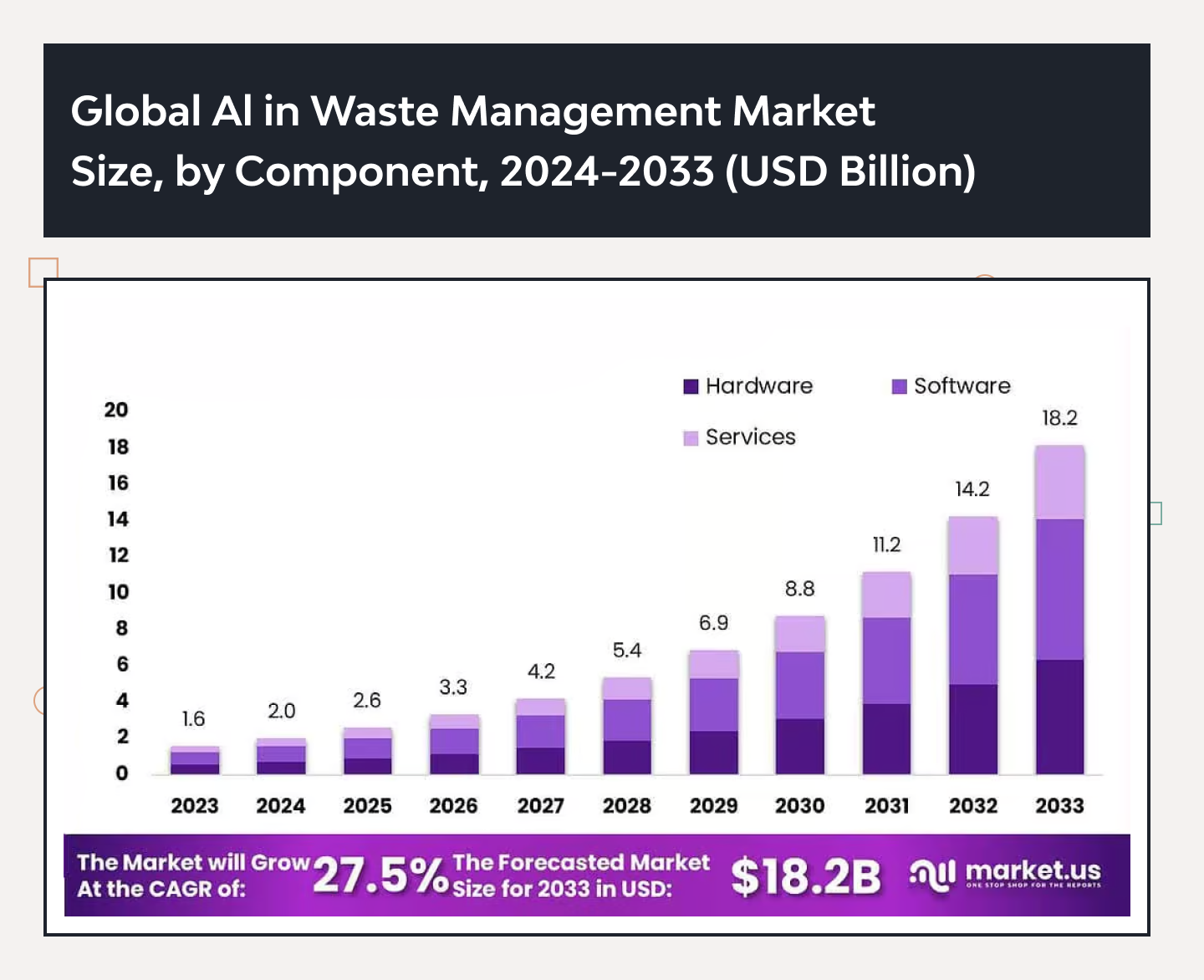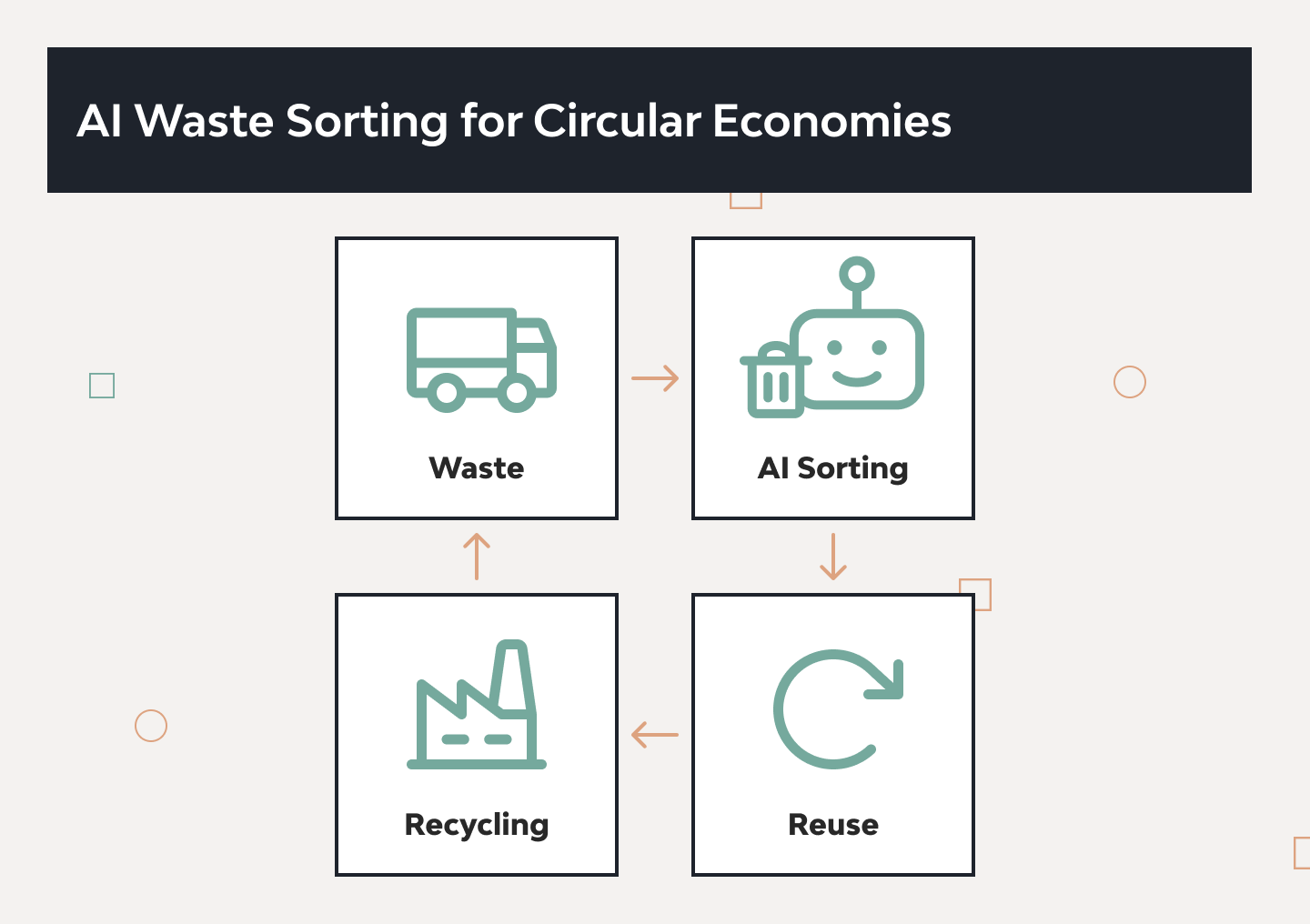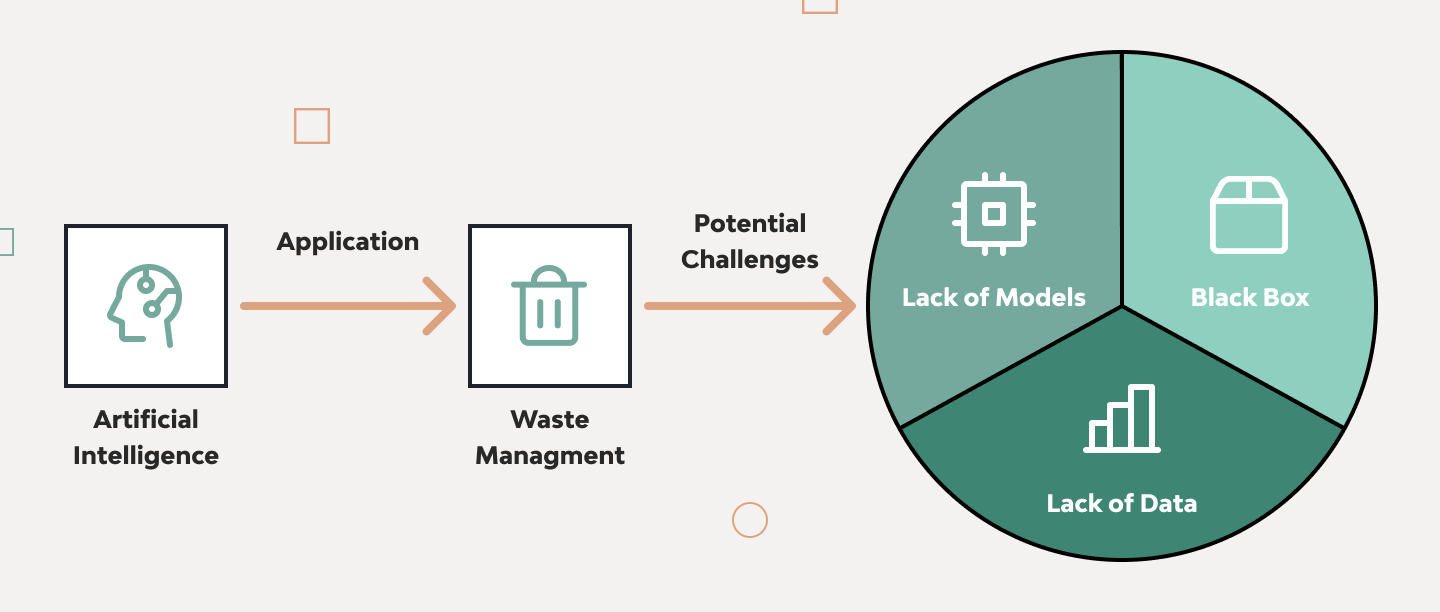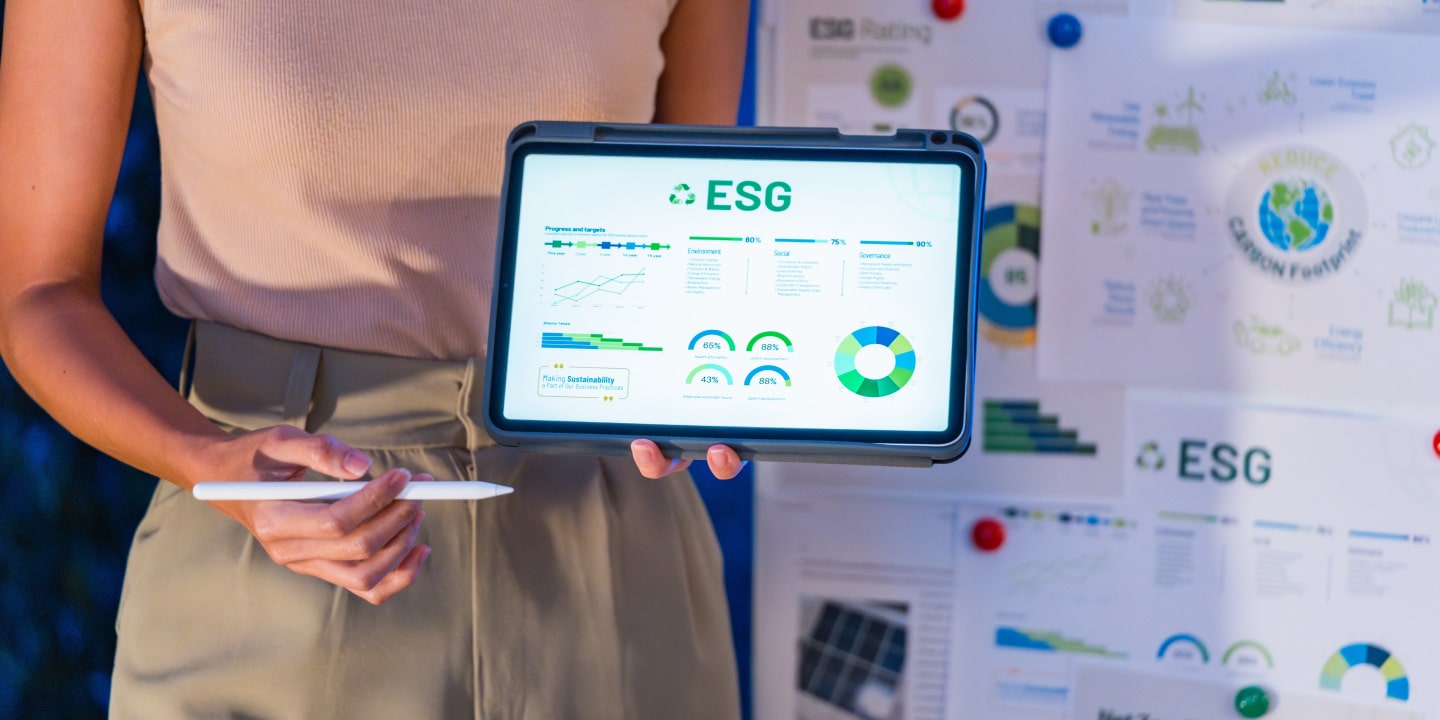How to Use AI in Waste Management to Cut Costs and Boost Efficiency

Inefficient garbage collection, rising waste volumes and the resulting costs and environmental harm are major disposal issues that cannot be postponed. In many cities, overflowing bins swamp local municipal services with unnecessary pickups or provoke garbage overflow events. Inaccurate waste sorting provokes more local contamination.
But things can be turned around with technology: AI-optimized logistics, smart sorting, and data insights can help make waste management cleaner, more accurate, and cost-efficient. The global market for AI waste management is currently at an all time high:
Let’s find out about the main cases, benefits, and cases of AI for waste management.
How AI is Revolutionising Waste Management
Smart tech for waste operations, like machine learning, computer vision, and robotics, helps automate the detection of garbage fill levels, predict waste generation trends, sort recyclables with higher accuracy, and scale logistics.
AI paves the way for legit sustainable waste automation, which is the priority for residential areas looking to adopt innovative city solutions. Every city and town has a managed waste disposal infrastructure. Applying AI solutions for waste-related operations can help mitigate or avoid altogether all of the above risks.
Key applications and real-world use cases
AI-powered hardware and digital tools for waste management are designed for optimized garbage collection, sorting, and analysis. AI is commonly used to optimize routes, power self-sorting smart bins, and extract insightful waste analytics.
#1 Waste collection
For quicker and more accurate garbage collection, you need to monitor two things: your collector trucks’ routes and the state of bins and containers.
-
Route optimization
AI algorithms can instantly analyze the state of the traffic, weather conditions, and vehicle data to help select the best routes and coordinate garbage collectors in real-time. Full or overfilled containers can be highlighted on an interactive map thanks to bin fill-level sensors.
To implement a system like that, garbage companies either use readymade platforms (e.g., Evreka) or turn to a provider (e.g., Django Stars) for a custom, individually built AI waste management solution.
-
Smart bins
Garbage containers, bins, and cans can be equipped with IoT sensors to monitor fill levels and autonomously trigger pickups, only when it’s necessary. This latest tech innovation in waste collection helps avoid extra trips, save on fuel, and generate less harmful emissions.
The smart bins technology is currently used in street garbage containers in San Francisco, Amsterdam, Singapore, Barcelona, Bulgaria, and other locations. Those are robotized, fully automated waste systems that look just like a regular container with a built-in display.
#2 Waste sorting
The related AI tech, like CV/NLP, robotics, and Big Data analysis, allows to expand intelligent waste management beyond just garbage collection.
-
Sorting robots and cameras
ML-powered smart sorting waste solutions are extremely accurate and sort garbage 80% faster as compared to manual, partially-automated, or non-AI systems. This allows for higher sorting performance while simultaneously reducing labor costs and contamination.
Waste recycling with AI has already been implemented in the facilities of Grundon waste disposal in the UK (has been using an AI-based Fast Picker robot since 2022) and Waste Connections in the USA (uses an AI platform to process up to 60,000 tons of recycled goods).
-
Food waste reduction
One of the major related issues in global and local waste management is the excessive production of food and the resulting organic waste. But AI-based recycling systems help mitigate the issue, allowing hotel and restaurant kitchens to track and cut food waste.
Smart cameras and automated scales are used to track kitchen waste more sensitively. In the long term, up to 50% of excess food and consumer leftovers can be prevented from going to waste.
#3 User engagement and analytics
By processing historical, real-time, and predictive data, AI and ML algorithms can help extract the insights you need for intelligent waste analytics.
-
Predictive analytics and planning
Facilities and plants can use AI’s data capacities for insight-driven smart waste management. IoT sensors installed on garbage containers are paired with analytics software to gather data on fill levels and pickup frequency.
The resulting historical, real-time, and predictive data can be leveraged to optimize the recycling rates, container usage, and garbage collection schedules. AI/ML algorithms enable automated forecasting of waste volumes, which is a major benefit for industrial recycling and disposal planning.
-
Citizen engagement tools
IoT networks can now be managed via user-friendly interfaces. Regular citizens can use them to locate trash bins more quickly, sort their garbage properly, and join collective waste management initiatives.
Several environmental nonprofits have been launching AI-based waste-sorting assistants, e.g., in Facebook or Telegram, to help users locate the nearest disposal stations via integrated maps and prompts.
Key benefits of AI for waste management
Startups, companies, and entire cities increasingly focus on AI technology in waste management due to the range of ultimate benefits they get. These include the following.
Environmental benefits
- Lower emissions
AI-optimized trash collection routes reduce truck’s travel distance and frequency, fuel use, and greenhouse gas emissions. Automated systems further reduce emissions by eliminating manual tasks. This allows for green efficiency gains that directly benefit urban air quality and climate preservation goals.
- Enhanced recycling
AI-driven sorting systems can distinguish between materials with high precision, making sure that more recyclables are captured and fewer end up in landfills. This improves trash recovery rates, reduces contamination in recycling streams, and helps set higher recycling targets.
- Support for sustainability
By enabling data-driven waste tracking, AI provides deeper insights that municipalities and businesses can use to recognize consumption patterns and disposal habits. This simplifies local sustainability planning, helping organizations cut waste at the source and fulfill green policy objectives.
- Circular economy goals
AI boosts material lifecycle management by making it easier to recover, repurpose, and reintegrate resources back into production cycles. With smarter sorting and predictive analytics, help industries close the loop, reducing reliance on raw materials while fostering a resilient circular economy.
Economic benefits
- Cost reductions
Smart cities and private operators can avoid extra costs by optimizing garbage collection routes based on sensor data. Automated waste sorting makes the collectors’ work simpler and recycling operations more cost-efficient. All that comes down to much fewer maintenance and fuel expenses.
- Labor savings
Major operating expenses can be potentially saved thanks to automation in waste management and predictive logistics. By eliminating cumbersome routes, retaining extra fuel, and reducing manual efforts, you naturally minimize labor demands. Workers also become free to focus on higher-value tasks.
- Avoidance of fines
With the data extracted by AI/ML, compliance with environmental regulations can be improved, helping organizations avoid costly penalties for improper disposal, recycling, or reporting. Furthermore, automated monitoring flags issues early, cutting more financial and reputational risks.
- Efficient resource planning
AI forecasting tools can predict trends in waste generation and mark peak periods. An operator can allocate trucks, staff, and processing capacities accordingly. This synced-up approach prevents overspending and helps make sure resources are deployed where they’re most needed.
Social benefits
- City infrastructure scaling
AI equips cities with smart tools that allow them to handle common issues more efficiently. This includes the tracking and servicing of growing populations, rising waste volumes, and contamination. Smart systems can adapt in real time and help expand infrastructures in line with urban growth.
- Citizen engagement and satisfaction
AI helps involve more people in using more green tech for waste management. Mobile and tablet apps can contain guidelines, interactive tips, and directions for smarter sorting of waste. Mobile apps for AI-first engagement encourage people to go out and pick up trash in their local area.
Challenges and considerations
AI waste management automation opens a whole new segment for smart city, IoT, and digital transformation solutions. However, this segment is still relatively young, and there are common issues and challenges. Here’s what you should be aware of and how to mitigate it.
Initial investment and ROI uncertainty
Implementing AI-powered waste services requires an investment: buying smart sensors and sorting robots, paying for backend systems and skilled personnel. The upfront cost range can easily intimidate, especially smaller municipalities or waste companies that need higher returns on their spending.
To mitigate this, any new waste-focused initiative should start with a targeted pilot project that demonstrates the quick value of the core concept. Then scale up once savings become tangible. It will allow you to grow ROI incrementally.
Technical integration and infrastructure roadblocks
Integrating AI waste management with the city’s legacy software and hardware is always challenging. You must force new AI into aging infrastructures, which results in compatibility issues, performance slowdowns, and operator frustration.
To ease the integration procedure, try a phased approach — create an MVP or only a non-critical subsystem first. You can also deploy an AI model in parallel during early stages, then expand its functionality using APIs.
Data quality, availability, and model explainability
The waste management AI model must be fine-tuned to fit your line of operations, for which you’ll need to source high volumes of reliable representative data. Generalized, limited, or corrupted assets won’t do. The sources and quality of data also define your AI model’s explainability and compliance.
To deal with this, any data-driven waste management solution must remain transparent and explainable. The representative data should be sourced from well-established data centers or providers.
How a strong software development partner mitigates all of the above
A sure way to handle all of the discussed issues and avoid hard-hitting risks is to partner up with a qualified provider that offers a range of AI-enabled services and has case studies to show for it.
At Django Stars, we:
- Consult and plan new projects, gather teams, and launch workflows with customized tech stacks.
- Develop MVPs and PoCs based on any relevant technology, scale AI models and early-stage products, and create full-cycle software solutions.
- Design user experiences and interfaces, provide UI/UX QA and testing, and refactor existing designs.
- Provide services for complex niches (AI, IoT, robotics, cloud, cybersecurity, etc.), continuously support projects, and share years of domain expertise.
The future: AI and smart city ecosystem
In cities worldwide, AI waste systems are becoming integrated with smart city infrastructures, syncing up with energy, traffic, and environmental monitoring platforms to enable unified, data-driven urban management.
Cities like Los Angeles and Palermo leverage AI-powered digital twins — dynamic simulations of their urban systems — to optimize traffic flow or plan for greener infrastructure in a safe, virtual environment. Copenhagen uses similar models to streamline disposal systems.
In Stockholm and Barcelona, waste collection data from smart bins is synchronized with AI energy grids and IoT-powered lighting. And in Macomb County, Michigan, drones like Elios 3 conduct automated sewer inspections and detect potential blockages before they become costly collapses.
In the long term, more AI waste management integrations across more smart city aspects will give municipalities and residential areas more advantages, like:
- Holistic operational intelligence
- Greater resilience to sudden events and forces of nature
- Cost savings across critical and non-critical infrastructures
- Visible macro-level environmental improvements
Conclusion
Today’s AI models, platforms, and tech providers are helping redefine how we handle waste and garbage at a new level of cost efficiency, performance, and sustainability. Off-the-shelf tools can help, but tailored platforms unlock the full potential of AI, whether through advanced route optimization, intelligent sorting, or data-driven sustainability planning.
At Django Stars, we’ve built a proven track record of delivering AI-powered software that helps organizations and municipalities modernize their waste management systems. Our expertise spans from concept to deployment.
If you found this article useful, consider sharing it with colleagues who are also exploring innovative ways to improve urban sustainability. You can also explore more of our resources to keep learning about how AI is reshaping industries.
Ready to take the next step? Contact Django Stars for a consultation and discover how a custom AI solution can drive higher results in your waste management strategy.
- What is AI in waste management?
- Waste management is the practice of implementing smart models and related tech (machine learning, computer vision, predictive analytics, etc.) to optimize how waste is collected, sorted, and processed. These systems help automate tasks, reduce inefficiencies, and improve recycling and sustainability statistics.
- What are the key benefits of using AI for waste management?
- The main benefits include: lower operating costs thanks to route and fuel optimization; higher recycling rates from smarter sorting; reduced emissions supporting environmental goals; and better, insight-driven planning for long-term sustainability. AI also improves compliance, citizen engagement, and overall service efficiency.
- What are the main challenges when implementing AI in waste management?
- The first difficulty lies in acquiring hardware, software, and training personnel without expecting any immediate ROI. Beyond that, AI systems need high-quality data and expert teams to run effectively, which can be more challenging if you need to integrate with legacy infrastructure or siloed data systems. Then, there’s compliance, which requires keeping AI / machine learning waste management practices transparent and non-intrusive.
- How can I get started with AI for my waste management business?
- Begin with an MVP or PoC — a barebone project to formulate and test out the concept, pitch it to audiences, and approve viability. You will need to pick an AI model to train and fine-tune, which can be an empty or pre-trained model. Depending on the scope and purpose of your solution, you will need a complete or partial product development cycle.






